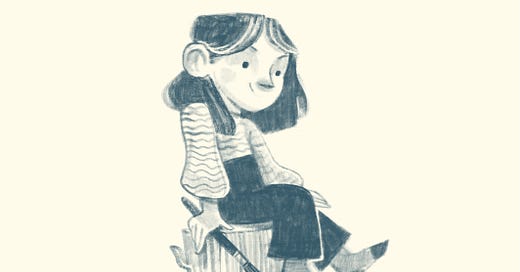Why skipping the art fundamentals held me back (and how I fixed it)
I used to think life drawing, color studies, and master copies were boring exercises. Turns out, they were exactly what I needed to develop my stylized art.
When I first started out as an artist, I believed true art came from pure imagination. I thought the best artists could create entire worlds from scratch—no references, no copying, no relying on real life. As a young, rebellious artist, I dismissed life drawing and photo references. It felt like cheating. To me, art had to be raw and imperfect, free from the constraints of technique. I prided myself on not being “academically” trained.
Well, I grew up.
It wasn’t until my mid-30s—when I stepped back and revisited the basics with an art tutor—that I realized how much I had been missing. I finally understood something essential: no matter how stylized or whimsical your art may be, having a solid technical foundation only makes it stronger. And this realization led me to embrace the very things I once ignored—studies, life drawings, and master copies.
In today’s post, I want to share how practicing art has influenced my style and how it can impact yours too.
I don’t draw realistically—so why bother?
Drawing from life is a game-changer for developing observational skills and understanding form, light, and proportion.
Take gesture drawing, for example. These quick, time-restrained sketches focus on the basic outline of the model and the energy of the pose. When I first took gesture drawing classes in my 30s, I didn’t see the point. My work wasn’t realistic—so why bother? But I soon realized that understanding how the human body moves gave my stylized characters a stronger foundation. They became more expressive, more dynamic, and full of life instead of looking stiff and static.
It’s one thing to create a character with exaggerated features, but without a grasp of anatomy, those exaggerations might feel awkward or unconvincing. For children’s book illustration, this is especially crucial. Even though your characters may not look realistic, understanding how they move makes them feel grounded and believable.
Still life exercises were another area I underestimated. I thought they were just about drawing bowls of fruit (boring, right?). But practicing them improved my ability to create depth, balance contrast, and refine composition—even in my stylized illustrations.
Color looked easy… Until I tried it
Once I gained confidence in my pencil sketches, I moved on to color and light studies. And let me tell you—this was one of the most challenging (and humbling) phases for me. Suddenly, all the confidence I had built up felt like it was slipping away. Understanding how color interacts with light, how shadows create depth, and how color choices set a mood—these were things I had never deeply considered before.
There’s a reason art courses recommend starting with black-and-white sketches before diving into color. Pencil drawings provide a solid foundation, but color is a whole different challenge. Children’s book illustration often relies on bright, bold colors to tell a story just as much as the characters themselves. But making those colors work together in a way that enhances the mood of an illustration takes knowledge and practice.
When I started studying these principles—things traditionally taught in classical art schools—I began making more intentional choices in my work. Even though I don’t paint in a realistic way, understanding how light and shadow work has helped me improve the storytelling aspects of my illustrations.
Copying other artists? No thanks—or so I thought
Another big shift in my artistic journey happened when I started doing master copies. At first, I resisted the idea. Why copy someone else’s work? If I wanted to be a true artist, I thought, I had to create something totally original. But after learning that many successful artists—both classical painters and modern illustrators—studied and copied the work of others, I decided to give it a try.
Master copies didn’t just mean replicating Renaissance paintings. I also studied contemporary artists who inspired me—especially character designers from Disney and Pixar. The more I analyzed their work, the more I realized how much I could learn. I studied how they used shape, color, and human anatomy to create characters. I paid attention to how exaggerated features still worked because they were rooted in solid anatomy.
Master copies helped me build a deeper appreciation for technical skill. But it’s not about blindly mimicking someone else’s style—it’s about understanding the why behind their design choices. With every copy I did I started to recognize how each decision was informed by a strong foundation in art fundamentals.
Mastering the basics isn’t restrictive—it’s freeing
Looking back, I can’t believe I ever thought practicing the fundamentals of art was boring or unnecessary. Now I see how essential these exercises are for developing a strong, stylized art style. Even though my illustrations are far from realistic, I hope they feel grounded in technical knowledge.
So if you’re like me and once thought that art was all about imagination and originality, it might be time to embrace the “boring” stuff. Drawing from life, copying the masters, and studying color theory may not seem like the most exciting activities, but they truly pay off in the long run.
What about you? How do you improve your skills? Do you sketch from life, observe nature, or find inspiration in other forms of art?
Hit reply and let me know—I’d love to hear your thoughts!
Until next time!












Great post Milena! You need to know the rules in order to break them. Doing these kind of exercises helps with training your eye to see and understand what you are drawing. I particularly like drawing kids while they play, from life not a picture.
Louder for the people in the back ! 😁